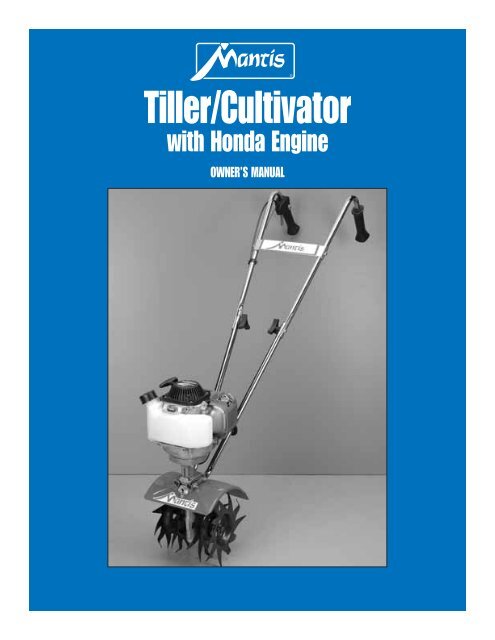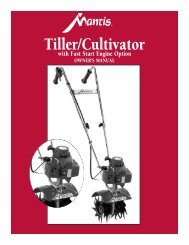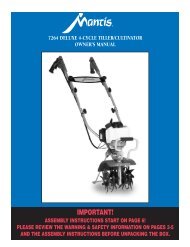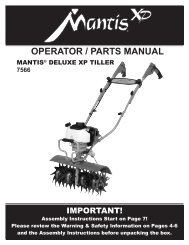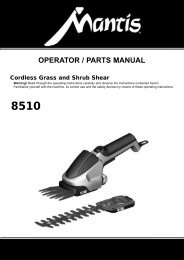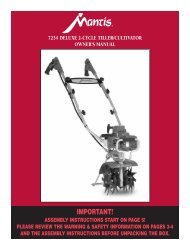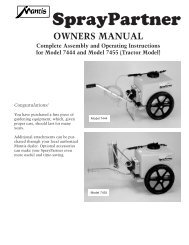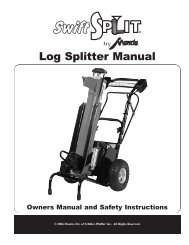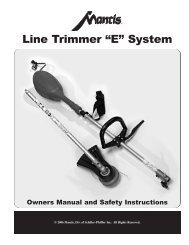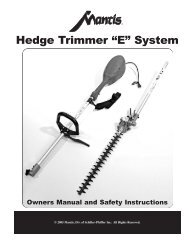Tiller/Cultivator
401726 Tiller-Cultivator - Mantis
401726 Tiller-Cultivator - Mantis
- No tags were found...
Create successful ePaper yourself
Turn your PDF publications into a flip-book with our unique Google optimized e-Paper software.
<strong>Tiller</strong>/<strong>Cultivator</strong><br />
with Honda Engine<br />
OWNER’S MANUAL
Welcome to the World of<br />
Mantis Gardening<br />
Here’s your new MANTIS <strong>Tiller</strong> . . .<br />
the lightweight wonder that’s Changing<br />
the Way Americans Garden. ®<br />
Unlike big tillers, your MANTIS <strong>Tiller</strong><br />
weighs only 21 pounds. So it lifts<br />
easily, handles smoothly, tills and<br />
weeds precisely. And, unlike other<br />
small tillers, it features serpentine tines<br />
that churn soil to ten inches deep. It<br />
creates a soft, smooth seed bed, even in<br />
problem soil.<br />
Once you know how to use your tiller<br />
correctly, we guarantee you’ll love it.<br />
So first, please read this manual. It<br />
shows, step by step, how to use your<br />
tiller safely. Plus, it shows how the<br />
MANTIS Border Edger can make light<br />
work of your edging needs.<br />
If you have questions about any topic<br />
in this Manual or if you wish to order<br />
MANTIS attachments, contact your<br />
local authorized Mantis Dealer.<br />
Table of Contents<br />
Safety Rules & Warnings . . . . . . . . . . . . . . . . . .3-5<br />
Safety Decals . . . . . . . . . . . . . . . . . . . . . . . . . . . .4<br />
Engine & Fuel Warnings . . . . . . . . . . . . . . . . . . .5<br />
Assembly and Mixing Fuel . . . . . . . . . . . . . . . .6-9<br />
Starting . . . . . . . . . . . . . . . . . . . . . . . . . . . . .10-11<br />
Additional Information . . . . . . . . . . . . . . . . . . . .11<br />
Getting to Your Garden . . . . . . . . . . . . . . . . . . .11<br />
Tilling & Cultivating . . . . . . . . . . . . . . . . . . .12-13<br />
Tine Positioning. . . . . . . . . . . . . . . . . . . . . . . . . 3<br />
Storage . . . . . . . . . . . . . . . . . . . . . . . . . . . . . . . .15<br />
Using The Border/Edger Attachment . . . . . . . . .16<br />
2<br />
MANTIS <strong>Tiller</strong> Assembly Layout . . . . . . . . . . .17<br />
Engine Parts Assemblies . . . . . . . . . . . . . . . . . .18<br />
Limited Warranty Information . . . . . . . . . . . . . .20
Safety rules & warnings<br />
You will notice throughout this Owners Manual Safety Rules and Important Notes. Make sure you understand<br />
and obey these warnings for your own protection.<br />
I. Special Safety Information<br />
!<br />
WARNING • DANGER<br />
ATTENTION: THIS SYMBOL POINTS OUT<br />
OUR IMPORTANT SAFETY INSTRUCTIONS.<br />
WHEN YOU SEE THIS SYMBOL,<br />
HEED IT’S WARNING!! STAY ALERT!!<br />
!<br />
!<br />
! WARNING • DANGER !<br />
TO REDUCE THE POTENTIAL FOR ACCIDENTS, COMPLY WITH<br />
THE SAFETY INSTRUCTIONS IN THIS MANUAL.<br />
FAILURE TO COMPLY MAY RESULT IN SERIOUS PERSONAL<br />
INJURY, AND/OR EQUIPMENT AND PROPERTY DAMAGE.<br />
II. Safety & Warnings<br />
! WARNING • DANGER !<br />
IMPROPER USE OR CARE OF THIS TILLER<br />
OR FAILURE TO WEAR PROPER PROTECTION<br />
CAN RESULT IN SERIOUS INJURY.<br />
READ AND UNDERSTAND THE RULES FOR SAFE OPERATION<br />
AND ALL INSTRUCTIONS IN THIS MANUAL.<br />
WEAR HEARING AND EYE PROTECTION.<br />
!<br />
WARNING: The Engine Exhaust from this product contains chemicals known<br />
to the State of California to cause cancer, birth defects or other reproductive harm.<br />
3
III. Safety Decal Information An important part of the safety system incorporated in this tiller<br />
are the warning and information decals found on various parts of the<br />
tiller. These decals must be replaced in time due to abrasion, etc. It is your<br />
responsibility to replace these decals when they become hard to read. The<br />
location and part numbers (P/N) of these decals are illustrated on Page 27.<br />
P/N 400620<br />
CUTTING HAZARD; KEEP<br />
FEET AND HANDS AWAY<br />
FROM ROTATING TINES.<br />
DO NOT CARRY THE TILLER<br />
IN THIS POSITION.<br />
READ OWNER’S MANUAL<br />
BEFORE USING TILLER, OR<br />
PERFORMING ANY REPAIR<br />
OR MAINTENANCE. KEEP<br />
OWNERS MANUAL IN A<br />
SAFE PLACE.<br />
DON’T FUEL, REFUEL, OR<br />
CHECK FUEL WHILE<br />
SMOKING, OR NEAR AN<br />
OPEN FLAME OR OTHER<br />
IGNITION SOURCE.<br />
P/N 400609<br />
CAUTION: WHEN<br />
ASSEMBLING THE HANDLES,<br />
MAKE SURE FUEL TANK FACES<br />
AWAY FROM OPERATOR. THIS<br />
IS THE REAR OF THE TILLER,<br />
REFER TO ASSEMBLY<br />
INSTRUCTION ON PAGE 7.<br />
INCORRECT ASSEMBLY.<br />
WEAR EAR AND EYE<br />
PROTECTION.<br />
! WARNING • DANGER !<br />
IF THE TILLER IS USED IMPROPERLY OR SAFETY PRECAUTIONS ARE NOT FOLLOWED,<br />
THE USERS RISK SERIOUS INJURY TO THEMSELVES AND OTHERS.<br />
READ AND UNDERSTAND THIS MANUAL BEFORE ATTEMPTING TO OPERATE THIS TILLER.<br />
IV. Warnings - Do’s<br />
Read and understand the owner’s<br />
manual. Pay particular attention to all<br />
sections regarding safety.<br />
1. Always keep a firm grip on both<br />
handles while the tines are moving and/or<br />
the engine is running. BE AWARE!! The<br />
tines may coast after throttle trigger is<br />
released. Make sure tines have come to a<br />
complete stop and engine is off before<br />
letting go of the tiller.<br />
2. Always maintain a firm footing and<br />
good balance. Do not overreach while<br />
operating the tiller. Before you start to use<br />
the tiller, check the work area for obstacles<br />
that might cause you to lose your footing,<br />
balance or control of the machine.<br />
3. Thoroughly inspect the area where<br />
equipment is to be used and remove all<br />
objects, which can be thrown by the<br />
machine.<br />
4. Always keep area clear of children,<br />
pets, and bystanders.<br />
5. Always stay alert. Watch what you<br />
are doing and use common sense. Do not<br />
4<br />
operate unit when fatigued.<br />
6. Always dress properly. Do not wear<br />
loose clothing or jewelry, they might get<br />
caught in moving parts. Use sturdy gloves.<br />
Gloves reduce the transmission of<br />
vibration to your hands. Prolonged<br />
exposure to vibration can cause numbness<br />
and other ailments.<br />
7. While working, always wear<br />
substantial footwear and long trousers. Do<br />
not operate the equipment when barefoot<br />
or wearing open sandals.<br />
8. Always wear ear and eye protection.<br />
Eye protection must meet ANSI Z 87.1.<br />
To avoid hearing damage, we recommend<br />
hearing protection be worn whenever<br />
using the equipment.<br />
9. To reduce fire hazard, keep the<br />
engine, and petrol/gas storage area free of<br />
vegetative material and excessive grease.<br />
10. Start the engine carefully,<br />
according to the manufacturer’s<br />
instructions and with feet well away from<br />
tool(s).<br />
11. Keep all nuts, bolts and screws<br />
tight to be sure the equipment is in safe<br />
working condition.<br />
12. Use extreme caution when<br />
reversing or pulling the machine towards<br />
you.<br />
13. Work only in daylight or good<br />
artificial light.<br />
14. Always be sure of your footing on<br />
slopes.<br />
15. Exercise extreme caution when<br />
changing direction on slopes.<br />
16. Always keep a safe distance<br />
between two or more people when<br />
working together.<br />
17. Always inspect your unit before<br />
each use and ensure that all handles,<br />
guards and fasteners are secure, operating,<br />
and in place.<br />
18. Always maintain and examine your<br />
<strong>Tiller</strong> with care. Follow maintenance<br />
instructions given in manual.<br />
19. Always store tiller in a sheltered<br />
area (a dry place), not accessible to<br />
children. The tiller as well as fuel should<br />
not be stored in a house.
V. Warnings - Don'ts<br />
Don’t use tiller with one hand.<br />
Keep both hands on handles with<br />
fingers and thumbs encircling the<br />
handles, while tines are moving,<br />
and engine is running.<br />
Don’t overreach. Keep a good<br />
footing at all times.<br />
Don’t run with the machine,<br />
walk.<br />
Don’t work on excessively<br />
steep slopes.<br />
Don’t attempt to clear tines<br />
while they are moving. Never try<br />
to remove jammed material before<br />
switching the engine off and<br />
making sure the tines have<br />
stopped completely.<br />
Don’t allow children or<br />
incapable people to operate this<br />
tiller.<br />
Don’t operate while under<br />
the influence of alcohol or drugs.<br />
Don’t attempt to repair this<br />
tiller. Have repairs made by a<br />
qualified dealer or repairman. See<br />
that only original Mantis parts are<br />
used.<br />
! WARNING • DANGER !<br />
HANDLE FUEL WITH CARE, IT IS HIGHLY FLAMMABLE. FUELING A HOT ENGINE OR NEAR AN IGNITION<br />
SOURCE CAN CAUSE A FIRE AND RESULT IN SERIOUS PERSONAL INJURY AND/OR PROPERTY DAMAGE.<br />
VI. Engine/Fuel Warnings - Do’s<br />
Always use fresh gasoline. Stale<br />
gasoline can cause damage.<br />
Always store fuel in containers<br />
specifically designed for this<br />
purpose.<br />
Always pull starter cord slowly<br />
until resistance is felt. Then pull cord<br />
rapidly to avoid kickback and<br />
prevent arm or hand injury.<br />
Always operate engine with spark<br />
arrestor installed and operating<br />
properly. The use of spark arrestor<br />
mufflers is required by law in the<br />
state of California (Section 4442 of<br />
the California Public Resources<br />
Code), as well as in other states or<br />
municipalities. Federal laws apply on<br />
federal lands.<br />
Stop the engine whenever you<br />
leave the machine.<br />
Allow the engine to cool before<br />
storing in any enclosure.<br />
If the fuel tank needs to be<br />
drained, this should be done<br />
outdoors.<br />
VII. Engine/Fuel Warnings - Don’ts<br />
Don’t fuel, refuel or check fuel<br />
while smoking, or near an open<br />
flame or other ignition source. Stop<br />
engine and be sure it is cool before<br />
refueling.<br />
Don’t leave the engine running<br />
while the tiller is unattended. Stop<br />
engine before putting the tiller<br />
down or while transporting from<br />
one place to another.<br />
Don’t refuel, start or run this<br />
tiller indoors or in an improperly<br />
ventilated area.<br />
Don’t run engine when electrical<br />
system causes spark outside the<br />
cylinder. During periodical checks<br />
of the spark plug, keep plug a safe<br />
distance from cylinder to avoid<br />
burning of evaporated fuel from<br />
cylinder.<br />
Don’t check for spark with<br />
spark plug or plug wire removed.<br />
Use an approved tester.<br />
Don’t crank engine with spark<br />
plug removed unless spark plug<br />
wire is disconnected. Sparks can<br />
ignite fumes.<br />
Don’t run engine when the odor<br />
of gasoline is present or other<br />
explosive conditions exist.<br />
Don’t operate the unit if<br />
gasoline is spilled. Clean up spill<br />
completely before starting engine.<br />
Don’t operate your tiller if there<br />
is an accumulation of debris around<br />
the muffler, and cooling fins.<br />
Don’t touch hot mufflers,<br />
cylinders or cooling fins as<br />
contact may cause serious burns.<br />
Don’t change the engine<br />
governor setting or over speed the<br />
engine.<br />
5
Assembly<br />
! WARNING•DANGER !<br />
IMPROPER ASSEMBLY OF THIS TILLER<br />
CAN RESULT IN SERIOUS INJURY.<br />
MAKE SURE TO FOLLOW ALL<br />
INSTRUCTIONS CAREFULLY.<br />
IF YOU HAVE ANY QUESTIONS<br />
CONTACT OUR FACTORY AT<br />
1-800-366-6268<br />
OR AN AUTHORIZED<br />
MANTIS DEALER<br />
8<br />
40 39<br />
20,21,55<br />
1<br />
2<br />
53<br />
42<br />
6<br />
Your MANTIS <strong>Tiller</strong> comes partially<br />
assembled. You must install only the<br />
handlebars, the carrying handle, and the<br />
tines. This will take just a few minutes if<br />
you follow the directions.<br />
First, take all items out of the<br />
carton. But do not remove the cardboard<br />
from around the <strong>Tiller</strong>’s base.<br />
The list at the right, shows the parts that<br />
come with your tiller. Check to make sure<br />
you have them.<br />
The bag of hardware is in the plastic bag<br />
containing the Owner’s Manual and Video.<br />
To assemble your MANTIS <strong>Tiller</strong>,<br />
you’ll need two 7/16" wrenches. We<br />
suggest that you install all nuts and bolts<br />
only “finger tight” — that is, one-half to<br />
one full turn — until you’ve completed<br />
assembly. The nuts are self locking, but<br />
you must use a wrench to tighten them<br />
completely.<br />
Quantity Description *Key #<br />
1 Upper Handle Assembly 2<br />
1 Upper Handle Throttle Side Assembly 1<br />
2 Lower Handles 6<br />
1 Pair <strong>Tiller</strong>/<strong>Cultivator</strong> Tines 39,40<br />
1 Engine Assembly (includes Fender<br />
Guard & Worm Gear Transmission) 20,21,55<br />
1 Handle Brace 8<br />
1 Plastic Carrying Handle 42<br />
1 Bag of Hardware Containing:<br />
2 Cap Screws 47<br />
4 Lock Nuts 48<br />
2 Bolts (3” long) 49<br />
2 Tine Retaining Pins 41<br />
2 Handle Clamps 51<br />
1 Throttle Clips 13<br />
2 Bolts 52<br />
2 Knobs 53<br />
*These numbers are the same numbers shown on the Parts<br />
Layout on page 18.<br />
6
Assembly (continued)<br />
HOW TO ASSEMBLE<br />
LOWER HANDLES<br />
To identify part numbers, see<br />
pages 6 and 18.<br />
1. Use the protective cardboard<br />
sleeve to stabilize your tiller. Stand<br />
the engine assembly (#21) up.<br />
(Picture 1)<br />
2. Lay the handle parts within<br />
easy reach. You’ll need one of the<br />
handle clamps (#51) and one of the<br />
lower handles (#6). Note that the<br />
lower handles have a short leg on<br />
one end.<br />
3. Fit the handle clamp along the<br />
outside of the short leg. Line up the<br />
holes on the clamp and the leg.<br />
4. Choose one of the two 3-inch<br />
bolts (#49). Slide it through the first<br />
set of holes — near the elbow where<br />
the lower handle curves. (Picture 2<br />
& 3)<br />
5. Now slide the other lower<br />
handle onto the 3-inch bolt. Fit<br />
the other clamp onto this other<br />
handle’s short leg. Add a nut<br />
and tighten finger tight.<br />
(Picture 3)<br />
6. Locate the worm gear<br />
housing. It starts just above —<br />
and extends down through —<br />
the tiller’s red fender guard.<br />
You’ll notice that there’s a<br />
recessed channel on either side of<br />
the housing’s top. (Picture 4.)<br />
7. Take the lower handles that<br />
you’ve just put together. Slide them<br />
into the two recessed<br />
channels.(Picture 5.)<br />
Make sure you insert them<br />
from the rear of the tiller . . . so that<br />
the bolt fits along the back of the<br />
housing.<br />
8. Slide the second 3-inch bolt<br />
through the second set of holes in<br />
the short legs. Add a nut and tighten<br />
finger tight.<br />
Picture 1<br />
NOTE: THE LOCK NUTS ARE STAMPED. FINGER TIGHT IS<br />
APPROXIMATELY 1/2 TO 1-1/2 TURNS.<br />
Picture 2<br />
Picture 3 Picture 4 Picture 5<br />
7
Assembly (continued)<br />
How to Assemble<br />
Upper Handles and<br />
Carrying Handle<br />
1. Lightly squeeze the lower<br />
handles (#6) toward one another<br />
so that they line up with the two<br />
smaller holes on the carrying<br />
handle (#42). Then slide the<br />
carrying handle over and down<br />
the lower handles. It will rest<br />
about four to six inches above the<br />
fender. (Picture 1)<br />
2. Gently pull the lower<br />
handles out to their original<br />
position.<br />
3. Attach the upper handle<br />
assembly (#1) – the handle with<br />
the throttle cable and ground wire<br />
– onto the right lower handle, and<br />
secure with the handle knob (#53).<br />
(Picture 2 and 3)<br />
Note: If throttle handle is<br />
mounted on the left, it will not<br />
fold down as completely as when<br />
mounted on the right.) Be sure<br />
you have proper throttle<br />
movements and that the throttle<br />
cable is not wrapped or twisted<br />
around the handle bar. Squeeze<br />
trigger and let go.<br />
THIS MUST BE DONE<br />
BEFORE STARTING THE<br />
ENGINE.<br />
4. Follow the same steps to<br />
install the other upper handle<br />
onto the other lower handle.<br />
(Picture 3)<br />
5. Use the clip (#13) to secure<br />
the throttle cable and wire in<br />
place on the lower handle.<br />
(Picture 4)<br />
6. Now install the Handle<br />
Brace. Line it up with the holes<br />
on the upper handles. Then insert<br />
a Cap Screw and a Lock Nut on<br />
either side (Picture 5)<br />
7. Use a wrench to tighten Cap<br />
Screws and Lock Nuts.<br />
8. Now use wrench to tighten<br />
all nuts and bolts firmly and<br />
securely.<br />
IMPORTANT NOTE:<br />
Make sure you have installed<br />
the handles properly. When<br />
you stand behind your tiller,<br />
holding the handles, the gas<br />
tank is facing away from you,<br />
on the front side of the engine.<br />
!<br />
WARNING: Improper throttle installation can cause<br />
tines to rotate unexpectedly .<br />
Picture 1<br />
! WARNING • DANGER !<br />
REMOVE TINES BEFORE STARTING ENGINE<br />
AND MAKING ADJUSTMENTS.<br />
Picture 2<br />
8<br />
Picture 3<br />
Picture 4 Picture 5
Assembly (continued)<br />
Assembling the Tines<br />
for Tilling<br />
1. Remove the cardboard from<br />
around your <strong>Tiller</strong>’s base.<br />
2. Slide the tines onto the axle<br />
shafts. The “D” hole goes on the<br />
outside.<br />
3. Make sure you’ve installed<br />
the tines properly for tilling.<br />
Liken the tines to your fingers.<br />
When your palm faces the<br />
ground, your fingers curl down.<br />
Stand behind the <strong>Tiller</strong> and hold<br />
your hand next to the tines. Do<br />
the tine blades curl down, as your<br />
fingers do? If so, they are in the<br />
tilling position. (To switch to the<br />
cultivating position, see page 12.)<br />
4. To secure each tine to the<br />
axle, insert a tine retaining pin.<br />
IMPORTANT NOTE:<br />
Before starting your<br />
Honda/Mantis <strong>Tiller</strong>, add the<br />
premeasured (3.4 oz.) bottle of<br />
Honda 4 -cycle engine oil. See<br />
Honda Engine Manual for<br />
details.<br />
IMPORTANT NOTE:<br />
Check the oil level in the engine before each use. Place the<br />
tiller on a level surface and rotate it forward until it rests on<br />
it’s gas tank. Remove the oil fill cap and make sure the oil is to<br />
the top (about to overflow). If oil is low, top it off with 10W-30<br />
before using. See your Honda Engine Manual for details.<br />
IMPORTANT NOTE:<br />
Before you use your<br />
MANTIS <strong>Tiller</strong>, read the<br />
Safety Rules & Warnings<br />
on pages 3-5.<br />
! WARNING • DANGER !<br />
FUEL IS EXTREMELY FLAMMABLE. HANDLE IT WITH<br />
CARE. KEEP AWAY FROM IGNITION SOURCES. DO NOT<br />
SMOKE WHILE FUELING YOUR EQUIPMENT.<br />
Never use starting fluids as they will cause permanent engine damage. Using them will void the warranty.<br />
Before you use the tiller, read the Safety & Warning rules on pages 3-6.<br />
9
Starting ! !<br />
TO START YOUR<br />
TILLER FOR THE<br />
FIRST TIME:<br />
First, fill the fuel tank with the<br />
proper amount of gasoline (Use<br />
branded 89 octane (R+M+2)<br />
unleaded gasoline or gasohol—<br />
maximum 10% ethyl alcohol, or<br />
15% MTBE, no methyl alcohol.)<br />
Mantis <strong>Tiller</strong> Starting<br />
Instructions (Honda 22cc<br />
engine)<br />
Cold Engine<br />
3. Place the o/I switch into the I<br />
“start/on” position. (Picture 1)<br />
2. Choke the engine (or close<br />
the choke. Move choke to the<br />
forward position.) (Picture 2)<br />
3. Push primer bulb 6 times.<br />
(Picture 3)<br />
4. Pull grip slowly until you feel<br />
resistance then pull briskly.<br />
(Picture 4)<br />
5. Once the engine is running,<br />
slowly push the choke lever<br />
back to the run position—the<br />
engine will continue to run.<br />
(Picture 5)<br />
Warm Engine<br />
1. Push ignition switch to I<br />
“start/on” position.<br />
2. Pull grip slowly until you feel<br />
resistance then pull briskly.<br />
Make sure the choke is in the<br />
open, or run, position.<br />
NOTE: When the choke is<br />
closed, never pull the cord more<br />
than four or five times. Overpulling<br />
may cause flooding.<br />
Follow these steps whenever<br />
you are starting the engine<br />
“cold”, or when the engine has<br />
run dry and you have just added<br />
fuel. Remember, always use<br />
short, brisk pulls. Don’t give the<br />
cord a long, forceful yank. And,<br />
do not let the cord snap back<br />
into the starter housing.<br />
How to Stop the<br />
Engine<br />
Simply push the o/I “stop/<br />
start” switch to “o” (Picture 6).<br />
Picture 1<br />
WARNING<br />
AVOID ACCIDENTAL<br />
BLADE ENGAGEMENT<br />
DO NOT SQUEEZE THE<br />
THROTTLE TRIGGER<br />
WHEN STARTING.<br />
MAINTAIN PROPER IDLE<br />
SPEED ADJUSTMENT<br />
(2500-3100 RPM)<br />
This will stop the engine instantly.<br />
If it should ever fail to do so, just<br />
pull out the choke button. The<br />
engine will stop at once.<br />
About the Choke<br />
The choke controls the amount of<br />
air drawn into the engine. Your tiller<br />
will run only if the choke is open.<br />
Picture 2 Picture 3<br />
Picture 4 Picture 5 Picture 6<br />
10
Additional Information<br />
! WARNING • DANGER !<br />
IF ENGINE DOES NOT STOP WHEN SWITCH IS PUT IN THE STOP POSITION, RELEASE THE<br />
THROTTLE, ALLOW ENGINE TO IDLE. PUT THE TILLER DOWN, AND SLIDE THE CHOKE LEVER<br />
FORWARD TO THE COLD START (CLOSED) POSITION.<br />
CHECK AND RETURN IGNITION SWITCH TO ON POSITION BEFORE STARTING ENGINE AGAIN.<br />
A Special Feature (with<br />
the idle set properly and<br />
the engine running)<br />
Even when the engine is<br />
running, the tines won’t turn<br />
unless you press the throttle lever<br />
on the handlebars. And, when<br />
you release the throttle lever, the<br />
tines will stop.<br />
A Tip for Extending<br />
Your Engine’s Life<br />
After you start the engine, let<br />
your tiller warm up for two to three<br />
minutes before you use it. Then,<br />
before you put your tiller away, let<br />
it idle for a minute to give the<br />
engine a chance to cool down.<br />
Operation<br />
With engine running, and both<br />
hands on the handles, press the<br />
throttle lock out button (Picture 4),<br />
then squeeze the throttle trigger<br />
gradually to increase the engine<br />
speed and engage the tines.<br />
NOTE: This step must be<br />
repeated each time your tiller<br />
trigger is released.<br />
NOTE: Once the throttle trigger<br />
is squeezed, you can release the<br />
lockout button (Picture 5).<br />
How to get your tiller to your garden<br />
Walk it.<br />
Once your tiller is running,<br />
you can “walk” it to your<br />
garden. Just press the throttle<br />
lever gently and let the tiller<br />
“tip-toe” across your yard on its<br />
tines. It won’t hurt your lawn or<br />
driveway. (Picture 1)<br />
Carry It.<br />
Make sure the engine is off.<br />
Then use one hand to grasp the<br />
convenient carrying handle. Use<br />
the other hand to hold the<br />
handlebars. (Picture 2) Then lift<br />
your tiller and carry it to your<br />
garden. Since it weighs only 21<br />
pounds, it won’t strain your<br />
muscles or tire you out!<br />
Take It for a Ride.<br />
You can easily transport your<br />
MANTIS <strong>Tiller</strong> to a friend’s or<br />
relative’s house. Just empty the<br />
fuel tank. (This is crucial.)<br />
Then stow your <strong>Tiller</strong> in the<br />
trunk of your car or truck. It fits<br />
easily. And you can put it in<br />
and take it our without straining<br />
your back.<br />
Picture 1<br />
Picture 2<br />
Picture 3<br />
Picture 4 Picture 5<br />
11
Tilling/Cultivating<br />
! WARNING • DANGER !<br />
IF YOUR TINES GET JAMMED OR ENTANGLED, SHUT OFF THE ENGINE AT ONCE.<br />
REMOVE THE OBSTRUCTION WHILE THE ENGINE IS OFF.<br />
NEVER TRY TO REMOVE AN OBSTRUCTION WHILE THE ENGINE IS RUNNING.<br />
SERIOUS INJURY CAN RESULT.<br />
How about a familysize<br />
vegetable garden?<br />
Nowadays many gardeners<br />
prefer small gardens —<br />
especially in the suburbs, where<br />
space is at a premium. But, if<br />
you’re fortunate enough to own a<br />
large lot, you can create a bigger<br />
garden — a half acre or more.<br />
Here’s how:<br />
1. First, hire someone with a<br />
tractor or big tiller to break<br />
ground for you. This is a onetime-only<br />
investment that’s well<br />
worth the small cost.<br />
2. Then, use your <strong>Tiller</strong> to<br />
break up any remaining clumps<br />
of soil or sod. Unlike a tractor or<br />
big tiller, your MANTIS <strong>Tiller</strong> is<br />
a precision tool. It will pulverize<br />
your soil into a smooth seed bed.<br />
12<br />
Picture 1 Picture 2<br />
Your MANTIS <strong>Tiller</strong><br />
Makes Weeding a<br />
Pleasure!<br />
As a tiller, your MANTIS<br />
<strong>Tiller</strong> works the soil down to 10”<br />
(25.4 cm) deep. But, as a<br />
cultivator, it gently cultivates the<br />
surface, only 2" to 3" (5.09 cm to<br />
7.62 cm) deep.<br />
First, you must switch the tines<br />
to the weeding position. This<br />
takes less than a minute.<br />
Then, your MANTIS <strong>Tiller</strong>’s<br />
sharp “tine teeth” will slice up<br />
those pesky weeds, burying them<br />
as you go along. And, since the<br />
tines in this position won’t dig<br />
too deep, they won’t hurt your<br />
plants’ precious root systems.<br />
The result? Your <strong>Tiller</strong> will<br />
cut your weeding time in half,<br />
and turn a tiresome chore into a<br />
pleasure.<br />
How to Switch From<br />
Tilling to Cultivating<br />
Position<br />
1. Make sure your <strong>Tiller</strong> of<br />
off.<br />
2. Remove the retaining pins<br />
from the tines.<br />
3. Remove the tines from the<br />
axle.<br />
4. Place the right-side tine onto<br />
the left-side axle. Place the left<br />
side tine onto the right-side axle.<br />
The “D” hole should be to the<br />
outside.<br />
5. Here is how to make sure<br />
you’ve installed the tines<br />
properly. Stand behind the <strong>Tiller</strong><br />
and hold your hand, palm up,<br />
next to the tines. Do the tine<br />
points curl up, as your fingers<br />
do? If so, they are in the correct<br />
cultivating position. (See photos<br />
on Page 13)<br />
6. Reinsert the pins.
Cultivating<br />
Tilling Position<br />
Tine teeth point in the same<br />
direction as the rotation of the<br />
tine; or toward the front of the<br />
<strong>Tiller</strong>, away from the operator.<br />
Now You’re Ready to<br />
Cultivate or Weed.<br />
Guide your <strong>Tiller</strong> where you<br />
want to weed and start it up. Pull<br />
your <strong>Tiller</strong> backward slowly, then<br />
let it move forward a bit, in a<br />
gentle rocking motion. Watch it<br />
slice, shred, and bury those<br />
weeds!<br />
Got tough weeds? Lighten your<br />
pressure on the throttle to slow<br />
your <strong>Tiller</strong> down. Then work back<br />
and forth until your <strong>Tiller</strong> chops<br />
up the weeds. It’s easy and<br />
effective!<br />
Remember, any tiller will<br />
tangle in tall grass, stringy vines,<br />
or super-big weeds. So, if you<br />
have a “backyard jungle,” first use<br />
a knife, pruner, or brush cutter to<br />
chop up the overgrowth. If the<br />
tines become tangled anyway,<br />
turn the engine off completely<br />
before trying to clear them.<br />
The optional tine Detangler<br />
(Item #1322) will clear tines in a<br />
jiffy. Contact your local<br />
authorized Mantis dealer.<br />
Cultivating Position<br />
Tine teeth point in the<br />
opposite direction as the rotation<br />
of the tine. Tines point toward<br />
the back of the tiller, or toward<br />
the operator.<br />
Your Mantis <strong>Tiller</strong> Will<br />
Weed Between Narrow<br />
Rows!<br />
Your Mantis <strong>Tiller</strong> is a<br />
precision weeder that easily fits in<br />
tight places. So don’t be afraid to<br />
weed anywhere: between plants<br />
and shrubs; in corners; against<br />
fences; on raised beds; in wide<br />
rows; even in very narrow rows.<br />
Your Mantis <strong>Tiller</strong> weeds six* to<br />
nine inches wide. So you can run<br />
it in a tightly planted garden<br />
without damaging your delicate<br />
plants. That’s good news for<br />
suburban gardeners, who often<br />
have to plant rows close together!<br />
*With optional Planter<br />
Furrower attachment<br />
(Item #62222.)<br />
13
Maintenance<br />
How to Check the Grease Level Inside the<br />
Worm Gear Housing<br />
When we built your MANTIS <strong>Tiller</strong>, we lubricated the<br />
worm gear housing thoroughly.<br />
It is imperative that you inspect the grease level once a year.<br />
Simply remove the cover plate on the worm gear housing.<br />
(Picture 1) Then check to make sure the grease comes almost<br />
to the top of the housing. If it doesn’t, add lithium #0 grease<br />
(Item M9985.) This is the only way to add grease to the worm<br />
gear housing. (Picture 1) To purchase Mantis grease, contact<br />
your local authorized Mantis dealer.<br />
Please do not overfill. Too much grease can create pressure,<br />
which could cause seals to fail or the clutch to slip.<br />
Picture 1<br />
How to Reseat the<br />
Flange<br />
At some point, you may find<br />
that the tines won’t turn when<br />
you press the throttle. This may<br />
mean the engine isn’t sitting all<br />
the way down on the worm gear<br />
housing.<br />
Perhaps you’ve been using<br />
your <strong>Tiller</strong> for several years.<br />
The flange bolt (Key #12, page<br />
18) may have come loose and<br />
lifted the engine up.<br />
If this happened you’ll notice<br />
a gap between the bottom of the<br />
engine flange (Key #43, page<br />
18) and the top of the worm gear<br />
housing. (Picture 2)<br />
To fix this, loosen the flange<br />
bolt. Take the engine off the<br />
worm gear housing. Notice the<br />
hex head on top of the drive<br />
shaft (Key #22, Page 18). Inside<br />
the flange housing, you’ll find<br />
the clutch drum (Key #57, Page<br />
18). Make sure the hex head<br />
lines up with the clutch drum<br />
inside the flange housing.<br />
Then put the engine back on the<br />
worm gear housing. Make sure<br />
the plastic carrying handle is not<br />
under the engine.<br />
If you’ve followed these steps<br />
properly, there will be no gap<br />
between the engine flange and the<br />
worm gear housing. (Picture 3)<br />
Make sure you tighten the flange<br />
bolt!<br />
Picture 3… Note how the<br />
engine sits all the way down on<br />
the transmission.<br />
Picture 2 … Note how the engine<br />
doesn’t sit all the way down on the<br />
transmission.<br />
14
Storage<br />
! WARNING • DANGER !<br />
DO NOT STORE IN AN AREA<br />
WHERE FUEL FUMES MAY ACCUMULATE<br />
AND REACH A FLAME OR SPARK.<br />
Each fall, or before you store your Mantis <strong>Tiller</strong><br />
for any long period, be sure to take these measures:<br />
1. Do not store your <strong>Tiller</strong> with fuel still in it.<br />
Even under ideal conditions, stored fuel containing<br />
ethanol or MTBE can start to go stale in 30 days.<br />
And, since stale fuel has a high gum content, it can<br />
clog the carburetor, this, in turn, will restrict fuel<br />
flow. Therefore, when you’re ready to store your<br />
<strong>Tiller</strong>, or will not be using it for more than 2<br />
weeks, drain the fuel tank completely.<br />
2. Next, restart the engine to make sure no fuel is<br />
left in the carburetor. Then, run the engine until it<br />
stops. This will prevent gum deposits, forming<br />
inside of the carburetor and possible engine<br />
damage.<br />
3. Disconnect spark plug wire and remove the<br />
spark plug. Slowly pull the starter cord once.<br />
4. Inspect the spark plug, and if necessary, clean it.<br />
It your need to replace it, buy a NGK-CR5H5B.<br />
5 Install the spark-plug, but leave the spark-plug<br />
wire disconnected.<br />
6. Clean the air filter.<br />
7. Clean dirt, grass and other materials from the<br />
entire machine.<br />
8. Wipe the tines with oil or spray them with WD-<br />
40, to prevent rusting.<br />
9. Oil the throttle cable and all visible moving<br />
part. (Don not remove the engine cover.)<br />
You may store your Mantis <strong>Tiller</strong> with the handles<br />
upright as in Picture 1 or with the handles folded<br />
down, as in Picture 2.<br />
Picture 1<br />
Picture 2<br />
15
Using the Border Edger Attachment<br />
Your MANTIS <strong>Tiller</strong> has been<br />
designed and built to accept a<br />
wide range of MANTIS <strong>Tiller</strong><br />
Attachments to increase its<br />
usefulness in your lawn and<br />
garden. And, all MANTIS <strong>Tiller</strong><br />
Attachments have been designed<br />
for quick and easy attachment to<br />
the <strong>Tiller</strong> or Engine.<br />
The Border Edger<br />
(Item #3222)<br />
The most popular attachment,<br />
the Border Edger can be used to<br />
cut clean, neat edges along<br />
walkways, or around trees, shrubs,<br />
and garden beds.<br />
The Border Edger has two<br />
parts: a wheel and a hardened<br />
steel blade, with pointed tines.<br />
How to Install the<br />
Border Edger<br />
The following instructions refer<br />
to “right” and “left” axles.<br />
Assume that you’re standing<br />
behind your <strong>Tiller</strong>, as you would<br />
for tilling and cultivating.<br />
Some areas of your yard may<br />
harbor roots and other<br />
underground obstructions. In<br />
places like this you’ll want to<br />
edge your borders shallowly (1”<br />
to 2” deep). Here’s how to install<br />
the Border Edger for shallow<br />
edging:<br />
1. First remove your<br />
tilling/cultivating tines.<br />
2. Then slide the edger’s wheel<br />
onto the right axle.<br />
3. Now slide the Edger blade<br />
onto the left axle. The blade’s<br />
angled face should hit the ground<br />
when you spin the blade forward.<br />
4. Insert retaining pins on both<br />
16<br />
left and right axles.<br />
Around walkways and garden<br />
beds, you’ll want to edge more<br />
deeply (3” to 4” deep). Here’s<br />
how to install the Border Edger<br />
for that purpose:<br />
1. Remove the<br />
tilling/cultivating tines.<br />
2. Slide the Edger’s blade onto<br />
the right axle. The blade’s pointed<br />
face should hit the ground when<br />
you spin the blade forward.<br />
3. Slide the wheel onto the left<br />
axle.<br />
4. Insert retaining pins on both<br />
sides.<br />
How to Use the<br />
Border Edger<br />
1. Position your MANTIS <strong>Tiller</strong><br />
so that the Edger blade is right<br />
along the garden edge and the<br />
wheel is outside (on the lawn, on<br />
the sidewalk, wherever). (Picture<br />
1)<br />
2. Start your <strong>Tiller</strong> and pull<br />
your MANTIS backward along<br />
the garden edge. (Picture 2)<br />
Picture 1<br />
The Border Edger Can<br />
Handle Special<br />
Projects!<br />
1. Install the Edger for deep<br />
edging, as directed above. Then<br />
use it to cut sod strips.<br />
2. Edge and weed at the same<br />
time! Just attach the Edger blade<br />
on one axle and a <strong>Tiller</strong> tine on<br />
the other axle, “Mix and match”<br />
blades; don’t be afraid to<br />
experiment.<br />
IMPORTANT NOTE:<br />
If you do a lot of edging, you’ll<br />
appreciate the MANTIS Wheel<br />
Set (Item#9222.) It gives you<br />
added stability, for even easier<br />
handling.<br />
To order the Wheel Set, or<br />
any Mantis Attachment, contact<br />
your local authorized Mantis<br />
dealer.
Mantis <strong>Tiller</strong> Assembly<br />
17
Mantis <strong>Tiller</strong> Assembly<br />
KEY # QTY MATERIAL<br />
KEY # QTY MATERIAL<br />
1 1 400256 TRIGGER HANDLE<br />
ASSM. RH<br />
2 1 400255 HANDLE ASSM. LH<br />
6 2 400224 LOWER HANDLE -<br />
FOLD DOWN<br />
7 1 400620 LABEL<br />
8 1 148 HANDLE BRACE<br />
12 1 910502 10-32 X 3/4 -<br />
FLANGED BOLT<br />
13 2 478 THROTTLE CLIP<br />
20 1 465 FENDER GUARD<br />
21 1 400905 ENGINE ASSY - 31CC<br />
HONDA<br />
22* 1 468 DRIVE SHAFT<br />
23 1 466 WORM GEAR<br />
HOUSING<br />
24 1 436 GASKET<br />
25 1 437A HOUSING COVER<br />
26 4 651 RD. HD. SELF<br />
TAPPING SCREW<br />
27 1 423 ROLLER BEARING<br />
28 2 425 WORM BEARING RACE<br />
29 1 424 WORM THRUST<br />
BEARING<br />
30 1 422 WORM SHAFT<br />
31 1 426 WORM DISK<br />
32 1 428 RETAINING RING<br />
33 1 429 WORM GEAR<br />
34 1 431 TINE SHAFT<br />
35 2 430 WORM GEAR THRUST<br />
WASHER<br />
36 2 432 WORM GEAR BEARING<br />
37 2 434 BEARING<br />
38 2 435 BEARING SEAL RETAINER<br />
39 1 438RA TINE ASSY - RT<br />
40 1 438LA TINE ASSY - LT<br />
41 2 418-1 TINE RETAINING HAIR PIN<br />
42 1 400133 CARRYING HANDLE<br />
43 1 400139 ENGINE FLANGE<br />
44 1 400609 TINE LABEL<br />
45 1 458 ROLLER BEARING<br />
46 1 4058 MANTIS LABEL<br />
47 2 410 CAP SCREW 1/4-20 X 1" LG.<br />
48 4 972 LOCK NUT 1/4 - 20<br />
49 2 470 1/4-20 X 3.25 BOLT<br />
50 2 140 BOLT 1/4 - 20 X 3/8" LG.<br />
51 2 377 HANDLE CLAMP<br />
52 2 400509 BOLT<br />
53 2 400510 KNOB<br />
54 2 400230 PLUG<br />
55 1 400010 TRANSMISSION ASSEMBLY<br />
56 1 400132 BEARING<br />
57 1 400138 CLUTCH DRUM<br />
58 1 400134 GAS TANK GUARD<br />
59 2 400512 M5 X 13 - SELF TAPPING BOLT<br />
60 4 400511 M6 X 12 - FLANGED BOLT<br />
* Also in Key #55<br />
18
Notes<br />
19
Limited Warranty Information for<br />
Mantis <strong>Tiller</strong><br />
MANTIS extends only to the original<br />
consumer purchaser a limited warranty against<br />
defects in material and workmanship for a<br />
period of two years from date of purchase.<br />
This warranty covers all portions of the<br />
MANTIS <strong>Tiller</strong>.<br />
MANTIS will repair or, at its option, replace<br />
any defective part or parts of the product free<br />
of charge. In the event of a defect or<br />
malfunction, the purchaser must return the<br />
product to an authorized MANTIS dealer.<br />
MANTIS assumes no responsibility in the<br />
event that the product was assembled or used in<br />
contravention of any assembly, care, safety, or<br />
operating instructions contained in the Owner’s<br />
Manual; was not used with reasonable care; or<br />
was used for other than normal and intended<br />
purposes.<br />
MANTIS MAKES NO EXPRESS<br />
WARRANTIES OR REPRESENTATION<br />
EXCEPT THOSE CONTAINED HEREIN. THE<br />
DURATION OF ANY IMPLIED WARRANTY,<br />
INCLUDING MERCHANTABILITY AND<br />
FITNESS FOR A PARTICULAR PURPOSE, IS<br />
LIMITED TO THE DURATION OF THE<br />
EXPRESS WARRANTY. MANTIS<br />
DISCLAIMS ALL LIABILITY FOR INDIRECT<br />
AND/OR CONSEQUENTIAL DAMAGES.<br />
SOME STATES DO NOT ALLOW<br />
LIMITATIONS ON HOW LONG AN IMPLIED<br />
WARRANTY LASTS AND/OR DO NOT<br />
ALLOW THE EXCLUSION OR LIMITATION<br />
OF INCIDENTAL OR CONSEQUENTIAL<br />
DAMAGES, SO THAT ABOVE LIMITATIONS<br />
AND EXCLUSIONS MAY NOT APPLY TO<br />
YOU. THIS WARRANTY GIVES YOU<br />
SPECIFIC LEGAL RIGHTS, AND YOU MAY<br />
ALSO HAVE OTHER RIGHTS WHICH VARY<br />
FROM STATE TO STATE.<br />
MANTIS<br />
1028 Street Road<br />
Southampton , PA 18966<br />
(215) 355-9700<br />
Specifications, descriptions, and illustrative material in this literature are as accurate as known at the time of publication, but are subject to change without notice.<br />
©2005 Mantis, Div. of Schiller-Pfeiffer, Inc. P/N 401726 08/05


